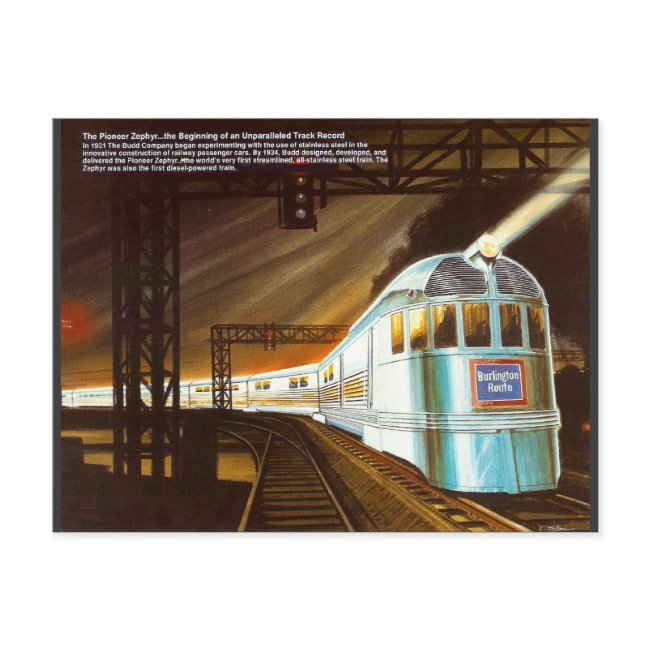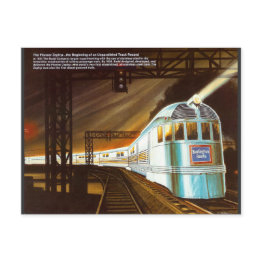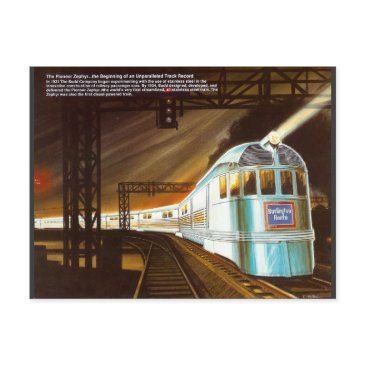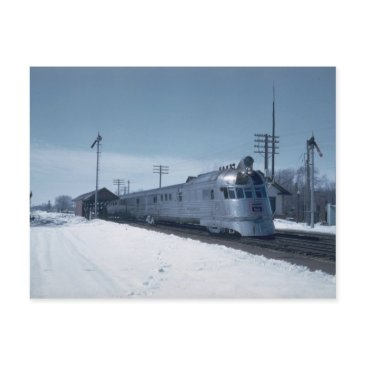The Pioneer Zephyr 1934 Postinvitations
$1.40 per Invitation
Get it for only $$0.84 per invitation Learn How
Get 40% Off
You can save as much as 50% on your invitations
| Order | Save | New Price |
|---|---|---|
| 25+ Invitations | 15% | $$1.19 Per Invitation ($$0.21 Off) |
| 50+ Invitations | 25% | $$1.05 Per Invitation ($$0.35 Off) |
| 100+ Invitations | 40% | $$0.84 Per Invitation ($$0.56 Off) |
| 250+ Invitations | 45% | $$0.77 Per Invitation ($$0.63 Off) |
| 1000+ Invitations | 50% | $$0.70 Per Invitation ($$0.70 Off) |
The Pioneer Zephyr 1948 The Pioneer Zephyr is a diesel powered railroad train formed of railroad cars permanently articulated together with Jacobs bogies, built by the Budd Company in 1934 for the Chicago, Burlington and Quincy Railroad (CB&Q), commonly known as the Burlington. The train featured extensive use of stainless steel, was originally named the Zephyr, and was meant as a promotional tool to advertise passenger rail service in the United States. The construction included innovations such as shotwelding (a specialized type of spot welding) to join the stainless steel, and articulation to reduce its weight. On May 26, 1934, it set a speed record for travel between Denver, Colorado, and Chicago, Illinois, when it made a 1,015-mile (1,633 km) non-stop "Dawn-to-Dusk" dash in 13 hours 5 minutes at an average speed of 77 mph (124 km/h). For one section of the run it reached a speed of mph (181 km/h), just short of the then US land speed record of 115 mph (185 km/h). The historic dash inspired a 1934 film and the train's nickname, "The Silver Streak". The train entered regular revenue service on November 11, 1934, between Kansas City, Missouri; Omaha, Nebraska; and Lincoln, Nebraska. It operated this and other routes until its retirement in 1960, when it was donated to Chicago's Museum of Science and Industry, where it remains on public display. The train is generally regarded as the first successful streamliner on American railroads. The first Zephyr was completed by Budd Company on April 9, 1934, powered by an 8-cylinder, 600-horsepower (447 kW), 8-201-A model Winton engine. Like the diesel electric locomotives that soon displaced the steam locomotive on American railroads, this engine powered an electrical generator; the electricity it generated was then fed to electric traction motors connected to the axles in the train's front truck. The train's engineer sat in a small compartment in the nose of the train, directly in front of the prime mover. Behind the engine in the first carbody was a 30 ft ( m) long railway post office section. The second carbody consisted of a small baggage section and a short buffet and 20-passenger coach section. The third and final carbody in the train, as originally built, was configured as half coach (40-passenger seats) and half observation car (12 passenger seats). As built, the train had 72 seats and could carry 50,000 pounds ( tonnes) of baggage and express freight. This train's official christening occurred on April 18, 1934, at the Pennsylvania Railroad's Broad Street Station in Philadelphia, Pennsylvania. Copyright © 1999-2022 Stan Feldman




